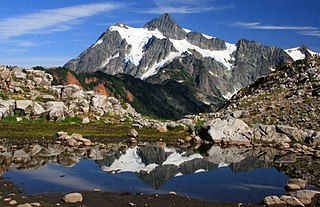
North Bend is a city in King County, Washington, United States, on the outskirts of the Seattle metropolitan area. The population was 7,461 at the 2020 census.

The Snoqualmie River is a 45-mile (72 km) long river in King County and Snohomish County in the U.S. state of Washington. The river's three main tributaries are the North, Middle, and South Forks, which drain the west side of the Cascade Mountains near the town of North Bend and join near the town of Snoqualmie just above the Snoqualmie Falls. After the falls the river flows north through rich farmland and the towns of Fall City, Carnation, and Duvall before meeting the Skykomish River to form the Snohomish River near Monroe. The Snohomish River empties into Puget Sound at Everett. Other tributaries of the Snoqualmie River include the Taylor River and the Pratt River, both of which enter the Middle Fork, the Tolt River, which joins at Carnation, and the Raging River at Fall City.

The North Cascades are a section of the Cascade Range of western North America. They span the border between the Canadian province of British Columbia and the U.S. state of Washington and are officially named in the U.S. and Canada as the Cascade Mountains. The portion in Canada is known to Americans as the Canadian Cascades, a designation that also includes the mountains above the east bank of the Fraser Canyon as far north as the town of Lytton, at the confluence of the Thompson and Fraser Rivers.

Snoqualmie Falls is a 268-foot (82 m) waterfall in the northwest United States, located east of Seattle on the Snoqualmie River between Snoqualmie and Fall City, Washington. It is one of Washington's most popular scenic attractions and is known internationally for its appearance in the television series Twin Peaks. More than 1.5 million visitors come to the Falls every year, where there is a two-acre park, an observation deck, and a gift shop.

State Route 202 (SR 202) is a state highway in the U.S. state of Washington, serving part of the Seattle metropolitan area. It runs southeasterly for 31 miles (50 km) in the Eastside region of King County, connecting Woodinville, Redmond, Fall City, and North Bend. The highway begins at SR 522 in Woodinville, intersects SR 520 in Redmond and SR 203 in Fall City, and terminates at Interstate 90 (I-90) in North Bend. The entire highway is designated as the Cascade Valleys Scenic Byway, a state scenic and recreational highway.

State Route 203 (SR 203) is a state highway in the U.S. state of Washington that traverses part of King and Snohomish counties. It runs north–south for 24 miles (39 km) through the Snoqualmie Valley, connecting Fall City, Carnation, Duvall, and Monroe. The highway terminates to the south at a roundabout with SR 202 near Fall City and to the north at a junction with U.S. Route 2 (US 2) in Monroe.

The Palouse to Cascades State Park Trail, formerly known as the John Wayne Pioneer Trail and the Iron Horse Trail, is a rail trail that spans most of the U.S. state of Washington. It follows the former railway roadbed of the Chicago, Milwaukee, St. Paul & Pacific Railroad for 300 miles (480 km) across two-thirds of the state, from the western slopes of the Cascade Mountains to the Idaho border.

The Snoqualmie Valley Regional Trail is a rail trail in King County, Washington. The 29-mile (47 km) trail follows a portion of the former alignment of the Milwaukee Road, which was constructed in 1911 and abandoned in 1973.

Olallie State Park is a public recreation area featuring multiple waterfalls located five miles (8.0 km) southeast of North Bend, Washington. The state park spans a 3.5-mile (5.6 km) stretch along the South Fork of the Snoqualmie River. The most prominent feature of the park is 135-foot-high (41 m) Twin Falls.

Interstate 90 (I-90), designated as the American Veterans Memorial Highway, is a transcontinental Interstate Highway that runs from Seattle, Washington, to Boston, Massachusetts. It crosses Washington state from west to east, traveling 298 miles (480 km) from Seattle across the Cascade Mountains and into Eastern Washington, reaching the Idaho state line east of Spokane. I-90 intersects several of the state's other major highways, including I-5 in Seattle, I-82 and U.S. Route 97 (US 97) near Ellensburg, and US 395 and US 2 in Spokane.

Snoqualmie Pass is a mountain pass that carries Interstate 90 (I-90) through the Cascade Range in the U.S. state of Washington. The pass summit is at an elevation of 3,015 feet (919 m), on the county line between Kittitas County and King County.
The Taylor River is a river in King County in Washington.
Bear Lake is a lake in King County in Washington, United States. It is the source of the Taylor River.
Deer Lake is a lake in King County, Washington. It is an expansion of the Taylor River, located just below its true source. Located a short distance downstream is Snoqualmie Lake.

Lake Dorothy is a lake in King County, Washington. First labeled on Oliver P Anderson's "New Map of the County of King, State of Washington, 1894"; the name was bestowed by Anderson for his daughter Dorothy Louise Anderson (1893-1912), a member of Sigma Kappa sorority. It is one of the largest lakes in the area and is the source of the East Fork Miller River.
Big Heart Lake is the most remote and highest-elevation on-trail lake in the West Fork Foss River system. It is a 14.6-mile (23.5 km) round-trip hike from the trailhead, just off of the Foss River Road. The lake is located at the eastern base of Camp Robber Peak in the Alpine Lakes Wilderness Area, within King County, Washington.

Deception Falls is a 94-foot (29 m) waterfall that flows from Deception Creek just over Stevens Pass, approximately 1856 feet above sea level, located in the U.S. state of Washington. Shortly downstream Deception Creek empties into Tye River. While flow may run dry in the late season, Deception Falls trail remains open in the Summer and Falls seasons. Deception Falls is located north of Interstate 90 in the Mount Baker–Snoqualmie National Forest. A hiking trail leads from a parking area to the falls.
Angeline Lake is a freshwater lake located on the northern slope of Iron Cap Mountain between Otter Lake, Azure Lake and Big Heart Lake, in King County, Washington. Self-issued Alpine Lake Wilderness permit required for transit within the Big Snow Mountain area. West Fork Foss River exits Angeline Lake into a canyon that produces Angeline Falls downstream from Chetwoot Lake to Delta Lake. Because Angeline Lake is at the heart of the Alpine Lakes Wilderness, the lake is a popular area for hiking, swimming, and fishing golden trout, rainbow trout, and cutthroat trout.
Marten Lake is a freshwater lake located on the southern slope of Dog Mountain in King County, Washington, United States. It is west of Anderson Lake, part of the Alpine Lakes Wilderness. Marten Creek exits Marten Lake into a canyon that produces a tributary to the Taylor River. Because of its proximity to Dog Mountain summit and the cirque of Rooster Mountain to the west, the lake is a popular area for hiking, swimming, and fishing cutthroat trout and rainbow trout. Access to Marten Lake is provided through an unmaintained access trail that splits off the Snoqualmie Lake Trail.
Dream Lake is a freshwater lake located on the southern slope of Dog Mountain in King County, Washington, United States. It is west of Otter Lake, part of the Alpine Lakes Wilderness. Big Creek, a tributary to the Taylor River, exits Dream Lake into a canyon that produces Big Creek Falls. Because of its proximity to Dog Mountain summit and the cirque of Rooster Mountain to the west, the lake is a popular area for hiking, swimming, and fishing and rainbow trout. Access to Dream Lake is provided through an unmaintained access trail that splits off the Snoqualmie Lake Trail.














